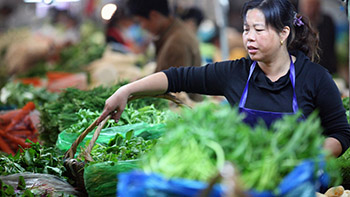
China’s official producer price index rose 1.2 per cent year-on-year in October, according to the National Bureau of Statistics, marking the second straight month of rising prices after 53 months of annualised contraction finally ended in September.
中国国家统计局(NBS)数据显示,今年10月中国工业生产者出厂价格指数(PPI)同比上涨1.2%,这是该指数连续第二个月同比上涨,此前53个月的下跌最终是在今年9月画上句号的。
A median forecast from economists had predicted a 0.9 per cent rise.
经济学家的预期中值为同比上涨0.9%。
That comes in spite of official figures released on Tuesday showing China’s exports had contracted for a second straight month in October, suggesting domestic demand is the main driver of price gains for producers.
周二发布的官方数据显示,中国的出口在今年10月出现了连续第二个月收缩,这表明内需是PPI上涨的主要推动因素。
Month-on-month producer prices rose 0.7 per cent, up from 0.5 per cent in September.
10月份的PPI环比上涨了0.7%,高于9月份0.5%的环比涨幅。
In an explanation released alongside the latest data, the statistics bureau credited ongoing growth in producer prices in part to coal extraction and washing prices, up 15.4 per cent for the period and accelerating 11.3 percentage points from a month earlier.
国家统计局在发布最新数据的同时进行了解读,它将PPI连续上涨部分归因于煤炭开采和洗选业价格同比上涨15.4%,这一涨幅比上月扩大11.3个百分点。
Consumer prices continued to rebound from an August dip, accelerating 0.2 percentage points to 2.1 per cent year on year, bang-on analysts’ median forecast.
居民消费价格指数(CPI)继续从8月份的低点反弹,10月份,CPI同比上涨2.1%,涨幅比上月扩大0.2个百分点,并与分析师的预期中值相符。
Pork prices, which are heavily weighted in the food-focused basket of goods used to calculate consumer inflation, rose 4.8 per cent.
猪肉价格同比上涨4.8%。猪肉在用来计算CPI的以食品为主的一篮子商品中占有较大权重。
Vegetable price growth more than doubled to 13 per cent year on year, helping push food inflation to 3 per cent, up from 2.7 per cent in September.
鲜菜价格同比上涨13%,助推食品价格同比上涨3.7%,涨幅比上月扩大0.5个百分点。
But the statistics bureau attributed the overall rise in CPI chiefly to a base effect resulting from low prices a year prior.
但国家统计局认为,CPI上涨的主要原因是去年同期对比基数相对偏低。
In month-on-month terms, consumer prices fell 0.1 per cent after having risen 0.7 per cent a month earlier.
10月份,CPI环比下降了0.1%,9月份则环比上涨了0.7%。











